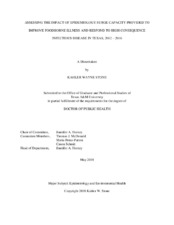| dc.contributor.advisor | Horney, Jennifer A. | |
| dc.creator | Stone, Kahler Wayne | |
| dc.date.accessioned | 2019-01-17T18:42:02Z | |
| dc.date.available | 2020-05-01T06:25:13Z | |
| dc.date.created | 2018-05 | |
| dc.date.issued | 2018-04-17 | |
| dc.date.submitted | May 2018 | |
| dc.identifier.uri | https://hdl.handle.net/1969.1/173493 | |
| dc.description.abstract | Background: Due to the decentralized structure of the public health system in Texas, Local Health Departments (LHDs) in Texas provide public health services for the majority of Texans. In response to increasing caseloads of foodborne illnesses and high consequence infectious disease investigations, the Department of State Health Services (DSHS) requested funding from the Texas Legislature in 2013 and 2015 for a new state funded epidemiologist (SFE) program.
Methods: A cross-sectional survey was implemented to quantify roles, responsibilities, and training of SFE LHD epidemiologists in Texas in 2017. Electronic disease reporting data on 42 conditions were extracted from 2012-1016 in all LHD jurisdictions. Median time and percentage of complete reports were analyzed and compared across time and between SFE and non-SFE jurisdictions using Mann-Whitney t-tests and Z scores. Key informant interviews (14 of 32 from LHDs; 4 of 8 from regional HDs; 3 of 6 from state health department) were conducted and inductively analyzed for emerging themes.
Results: For LHDs included in this study, the mean number of epidemiologists per 100,000 was 0.73 in medium LHDs and 0.46 in large LHDs. The median time of disease processing improved from 14 days to 8 days between 2012 to 2016 and the percentage of case reports that were complete on first submission improved from 19.6 % to 27.7%. Improvements in quality of disease investigations, communication, timeliness, and overall epidemiology capacity within the LHD were noted.
Discussion: SFE positions makeup approximately 40 percent of the LHD epidemiologic workforce and 56 percent of medium sized LHD epidemiology staff in Texas. Through this program, DSHS has increased epidemiology capacity almost two-fold from 0.28 to 0.47 epidemiologists per 100,000 people. The proportion of disease reporting improvements in timeliness and completeness was primarily due to the SFE workforce handling the majority of disease reports in Texas. All key informants agreed and described the positive impact on disease surveillance of the SFEs. Local epidemiology capacity has increased and, in turn, Texas public health surveillance capacity has improved at the state level. | en |
| dc.format.mimetype | application/pdf | |
| dc.language.iso | en | |
| dc.subject | Epidemiology | en |
| dc.subject | capacity | en |
| dc.subject | surveillance | en |
| dc.title | Assessing the Impact of Epidemiology Surge Capacity Provided to Improve Foodborne Illness and Respond to High Consequence Infectious Disease in Texas, 2012 – 2016 | en |
| dc.type | Thesis | en |
| thesis.degree.department | Epidemiology and Biostatistics | en |
| thesis.degree.discipline | Epidemiology and Environmental Health | en |
| thesis.degree.grantor | Texas A & M University | en |
| thesis.degree.name | Doctor of Public Health | en |
| thesis.degree.level | Doctoral | en |
| dc.contributor.committeeMember | McDonald, Thomas J. | |
| dc.contributor.committeeMember | Perez-Patron, Maria | |
| dc.contributor.committeeMember | Schmit, Cason | |
| dc.type.material | text | en |
| dc.date.updated | 2019-01-17T18:42:02Z | |
| local.embargo.terms | 2020-05-01 | |
| local.etdauthor.orcid | 0000-0001-8805-9514 | |


